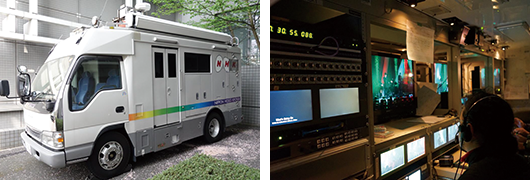Research Area
2.1 Video systems
We are conducting R&D on a program production system for full-featured 8K, which is the ultimate format of Super Hi-Vision (SHV), and research on program production methods for high-dynamic-range television (HDR-TV) and its synergy effects.
■Full-featured 8K program production system
We continued with our R&D on program production equipment and systems that support a 120-Hz frame frequency with the goal of realizing full-featured 8K program production. To enable live program production and transmission experiments outside the broadcast stations, we installed our previously developed full-featured 8K production equipment and transmission equipment using dense wavelength division multiplexing(1) in an experimental production van(2). Using the experimental production van, we conducted operation tests and confirmed that there was no major issue with the interconnectivity and operability of the installed equipment (Figure 2-1).
As new full-featured 8K production equipment, we developed a video editing system that can input/output 8K/120-Hz video and 22.2 ch sound in real time to enable the creation of highlight video during live program production. We also began a study on full-featured 8K production using Internet Protocol (IP) interfaces and prototyped a device for comparative evaluation of the image quality of multiple lightweight compression codecs.
We researched measurement methods for the sensitivity and signal-to-noise ratio of TV cameras, which are useful for full-featured 8K program production, and compiled our findings into ARIB Technical Report TR-B45. In addition, we analyzed the relationship between the edge direction of an image and the measurement accuracy and precision of the modulation transfer function (MTF), which indicates the spatial resolution characteristics of a TV camera(3). This led to the identification of practical measurement conditions and parameters(4).
■High-dynamic-range television
For the program production of high-dynamic-range television (HDR-TV), which can reproduce a wider range of brightness than conventional televisions, we developed a conversion method between high dynamic range (HDR) content and standard dynamic range (SDR) content. We adopted a dynamic range conversion function in which a linear function and log function are combined for converting HDR content to SDR content and demonstrated that the function can produce converted SDR content with a quality comparable to that of directly produced SDR content (5). We contributed these results to the International Telecommunication Union, Radiocommunication Sector (ITU-R) and our contribution were incorporated into ITU-R Report BT.2446.
Since HDR video expands the range of brightness that can be reproduced, it is necessary to set an objective metric for ensuring consistency in brightness to prevent unpleasantness given by excessively bright images to viewers. We began a study to develop the metric. We statistically demonstrated through subjective evaluation tests that the average of displayed pixel luminance level is not sufficient for the metric and found that correction using the angle at which each pixel is viewed and the luminance distribution is effective(6). We also studied the perceived diffuse white level when viewing HDR video. The results of subjective evaluation tests demonstrated that the perceived diffuse white level is not the same as the peak luminance of a display but lower than the peak luminance(7).
A display color gamut renders a complex shape in a 3D uniform color space (a space in which a perceived color difference corresponds to a distance in the 3D space represented by hue, chroma and lightness) that can be reproduced by displays supporting HDR and a wide color gamut, and it is therefore difficult to represent it in two dimensions. To address this problem, we devised a "Gamut Rings" that develops a color gamut in 2D while saving the color volume per unit lightness and unit hue angle(8). This method enabled the 2D evaluation of the volume and shape of a color gamut represented in 3D.

Figure 2-1. Experimental full-featured 8K production van (left) and operation test (right)
| [References] | |
| (1) | T. Hayashida, D. Koide, J. Yonai, A. Arai, S. Aoki, K. Miura, Y. Takiguchi, Y. Nishida: "Development of compact dense wavelength division multiplexing transceivers for full-featured 8K," ITE Annual Convention 2018, 13D-2 (2018) (in Japanese) |
| (2) | A. Arai, T. Hayashida, D. Koide, J. Yonai, S. Aoki, K. Miura, Y. Kikuchi, Y. Takiguchi, Y. Nishida: "Development of Full-Featured 8K Production system Outside Broadcasting Station," ITE Annual Convention 2018, 13D-3 (2018) (in Japanese) |
| (3) | K. Masaoka: "Accuracy and precision of edge-based modulation transfer function measurement for sampled imaging systems," IEEE Access, Vol.6, pp.410479-41086 (2018) |
| (4) | K. Masaoka: "Practical edge-based modulation transfer function measurement," Optics Express, Vol.27, No.2, pp.1345-1352 (2019) |
| (5) | K. Nomura, Y. Kusakabe, Y. Ikeda, and Y. Nishida: "Method for HDR to SDR conversion considering HDR Reference White," Proc. IDW/AD'18 (2018) |
| (6) | Y. Ikeda, and Y. Kusakabe: "Subjective Evaluations on Perceptual Image Brightness in High Dynamic Range Television," Proc. IS&T Electronic Imaging (2019) |
| (7) | F. Jiang, K. Masaoka, and M. Fairchild: "Subjective Verification for Color Gamut Volume of HDR WCG Display," Proc. IDW/ AD'18 (2018) |
| (8) | K. Masaoka, F. Jiang, M. Fairchild, and R. Heckaman: "2D Representation of Display Color Gamut," SID International Symposium (2018) |